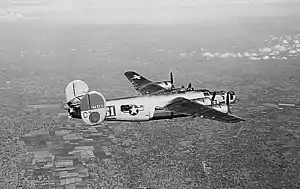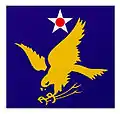726th Bombardment Squadron
The 726th Bombardment Squadron is a former United States Army Air Forces unit. It was last assigned to the 451st Bombardment Group at Dow Field, Maine, where it was inactivated on 26 September 1945. The squadron was activated during World War II as one of the original squadrons of the 451st Bombardment Group. After training in the United States, it served in the Mediterranean Theater of Operations, where it participated in the strategic bombing campaign against Germany. It earned three Distinguished Unit Citations for its combat actions. After VE Day the squadron returned to the United States, where it was inactivated.
| 726th Bombardment Squadron | |
|---|---|
 | |
| Active | 1943-1945 |
| Country | |
| Branch | United States Army Air Forces |
| Role | heavy bomber |
| Engagements | Mediterranean Theater of Operations |
| Decorations | Distinguished Unit Citation |
| Insignia | |
| 726 Bombardment Sq emblem (approved 8 July 1944)[1] |  |
History
Organization and training in the United States
The squadron was first activated at Davis-Monthan Field, Arizona as one of the four original squadrons of the 451st Bombardment Group.[1][2] Although original plans were for the squadron to be an Operational Training Unit at Davis-Monthan, instead a cadre of the 451st Group moved to Dyersburg Army Air Base, Tennessee, where the 726th and other elements of the group were filled out by personnel drawn from the 346th Bombardment Group. The squadron commander, Capt Charles C. Haltom, and a model crew joined other members of the group for advanced tactical training with the Army Air Forces School of Applied Tactics at Orlando Army Air Base, Florida. This cadre joined the remainder of the squadron at Wendover Field, Utah for training with the Consolidated B-24 Liberator.[3] The squadron continued its training at Fairmont Army Air Field, Nebraska, starting in September.[1] On 18 November, the air echelon of the squadron departed Fairmont for staging at Lincoln Army Air Field, Nebraska to ferry their aircraft via the Southern Ferrying Route to the Mediterranean Theater of Operations. The ground echelon left on 26 November for the Port of Embarkation at Camp Patrick Henry, Virginia for transportation by ship.[4]
Combat operations
The squadron arrived at Gioia del Colle Airfield, Italy at the beginning of January, although the air echelon remained at Telergma Airfield, Algeria until 20 January to conduct additional training.[5] The squadron functioned primarily as a strategic bombing unit, attacking targets like oil refineries, marshalling yards, aircraft factories and airfields in Italy, Germany, France, Czechoslovakia, Austria, Bulgaria, Hungary, Romania, Greece and Albania. It earned a Distinguished Unit Citation during Big Week, Eighth Air Force's campaign against German aircraft manufacturing plants, for an attack on a Messerschmitt aircraft factory at Regensburg, Germany on 25 February 1944. It added oak leaf clusters to this award for an attack on oil refineries and marshalling yards at Ploesti, Romania on 5 April 1944 and on Markersdorf-Haindorf Airfield near Vienna, Austria on 23 August 1944. On each of these missions the squadron was opposed by large numbers of enemy interceptor aircraft and heavy flak, but fought its way through to inflict serious damage on the targets and destroy many enemy aircraft.[2]
When returning from the Regensburg attack, runway conditions at Gioia del Colle were so poor that the aircraft of the 451st Group were unable to land there, but spread out among a number of bases in Italy. These poor conditions continued and on 8 March the squadron moved to San Pancrazio Airfield, Italy. The 451st Group's 724th Bombardment Squadron was also relocated there[1][6]
On 6 April, the 726th moved to Castelluccio Airfield, where it joined the remainder of the group. From its new base, the squadron also flew air support and interdiction missions. It helped prepare the way for Operation Dragoon, the invasion of southern France in August 1944. The following month its bombers transported supplies to forces operating in Italy, It also supported Operation Grapeshot the final advance of Allied armies in northern Italy.[2] The squadron flew its last mission on 26 April 1945 against marshalling yards at Sachsenburg, Austria.[7]
The squadron left Italy in June 1945. The air echelon ferried their planes back to the United States, while most of the ground echelon sailed on the USS General M. C. Meigs to Newport News, Virginia.[8] The squadron assembled later in the month at Dow Field, Maine, where it was inactivated on 26 September 1945.[1] Personnel that were not discharged from the service on return to the United States were transferred to Air Transport Command units at Dow.[8]
Lineage
- Constituted as the 726th Bombardment Squadron (Heavy) on 6 April 1943
- Activated on 1 May 1943
- Redesignated 726th Bombardment Squadron, Heavy on 10 May 1943
- Inactivated on 26 September 1945[1]
Assignments
- 451st Bombardment Group, 1 May 1943 - 26 September 1945[1]
Stations
|
|
Aircraft
- Consolidated B-24 Liberator 1943–1945[1]
Awards and campaigns
| Award streamer | Award | Dates | Notes |
|---|---|---|---|
| Distinguished Unit Citation | 25 February 1944 | Regensburg, Germany[1] | |
| Distinguished Unit Citation | 5 April 1944 | Ploesti, Romania[1] | |
| Distinguished Unit Citation | 23 August 1944 | Austria[1] |
| Campaign Streamer | Campaign | Dates | Notes |
|---|---|---|---|
| Air Offensive, Europe | 2 January 1944–5 June 1944 | [1] | |
| Air Combat, EAME Theater | 2 January 1944–11 May 1945 | [1] | |
| Naples-Foggia | 2 January 1944–21 January 1944 | [1] | |
| Anzio | 22 January 1944–24 May 1944 | [1] | |
| Rome-Arno | 22 January 1944–9 September 1944 | [1] | |
| Normandy | 6 June 1944–24 July 1944 | [1] | |
| Northern France | 25 July 1944–14 September 1944 | [1] | |
| Southern France | 15 August 1944–14 September 1944 | [1] | |
| North Apennines | 10 September 1944–4 April 1945 | [1] | |
| Rhineland | 15 September 1944–21 March 1945 | [1] | |
| Ardennes-Alsace | 16 December 1944–25 January 1945 | [1] | |
| Central Europe | 22 March 1944–21 May 1945 | [1] | |
| Po Valley | 3 April 1945–8 May 1945 | [1] |
References
Notes
- Maurer, Combat Squadrons, p. 722
- Maurer, Combat Units, pp. 325-326
- History of the 451st Group, pp. 1-2
- History of the 451st Group, pp. 7-9
- History of the 451st Group, p. 10
- History of the 451st Group, p. 11
- History of the 451st Group, p. 33
- History of the 451st Group, p. 35
Bibliography
![]() This article incorporates public domain material from the Air Force Historical Research Agency website http://www.afhra.af.mil/.
This article incorporates public domain material from the Air Force Historical Research Agency website http://www.afhra.af.mil/.
- Maurer, Maurer, ed. (1983) [1961]. Air Force Combat Units of World War II (PDF) (reprint ed.). Washington, DC: Office of Air Force History. ISBN 0-912799-02-1. LCCN 61060979.
- Maurer, Maurer, ed. (1982) [1969]. Combat Squadrons of the Air Force, World War II (PDF) (reprint ed.). Washington, DC: Office of Air Force History. ISBN 0-405-12194-6. LCCN 70605402. OCLC 72556.
- Unknown. "History of the 451st Bombardment Group (H)" (PDF). 451st Bombardment Group Association. Retrieved 30 March 2019.
.svg.png.webp)
